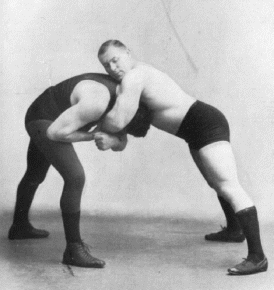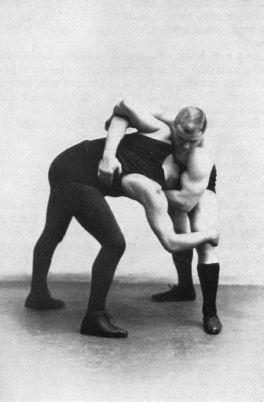The Head Chancery
as taught by George Hackenscmidt in
The Complete Science of Wrestling
George Hackenschmidt, known as the Russian Lion, was born in Russia, but lived nearly all his life in London.
His specialty was Graeco-Roman, but he made a match with Gotch at the American Style. The contest took place in Chicago on April 3, 1908, and Hackenschmidt quit after a rough combat lasting two hours and three minutes.
He was an amazing athelete with an unparrelled physique for his time, and an attention to technique that matched. Here he describes the Head Chancery Hold, as taught in his book COMPLETE SCIENCE OF WRESTLING.
"There are points which no wrestler should fail to study thoroughly. He must remember that ther are counters to most wrestling holds, and that just at the moment he is congratulating himself that he is on the high road to victory, he is frequently in serious danger of defeat."---- George Hackenschmidt
The Head Chancery Holds and the
Stops To Some Of Them
On coming to head-holds and breaking suddenly from them, it frequently happens that one may offer a waist, or leg, or even a double leg-hold to a rushing adversary; practically any opening which may tempt such an opponent to come in quickly with his head and arms down, when by a quick movement of the body and arm the offered hold may be withdrawn slightly and the opponent's head trapped in chancery by throwing either arm round his neck from above
There are, of course, other methods of securing this position, such as pulling a man's head down and forward suddenly and trapping his head as he
comes, clutching it closely to your side.
You may now lever him over sideways and endeavor to force him on to his shoulders, but this is a lengthy and laborious proceedings with numerous possibilities of escape. The best and most effective throw, and, indeed, a practically certain one, unless your adversary is acquainted with the counter, is exceedingly simple.
Retain a firm hold of the head and face, and fall backwards yourself{ turning sideways as you go, but being careful to fall on your left shoulder (supposing that you have your opponent's head trapped under your left arm). He must go on to his right shoulder, and, as you can roll easily over on to his chest, he cannot escape being pressed down and pinned.
That is, unless he knows the counter or stop, which, like the fall, is also simplicity itself.
My readers may be acquainted with it, but if they are not, the following hints may be found useful.
Suppose that one of you may be trapped in the chancery-hold above described, and find that your adversary is about to fall back with you for the throw in question, don't resist, go with him easily, but, as you go, straddle your legs across him
He will fall on his shoulder right enough, but you will now be on top, and, struggle as he may (provided you have. shifted your weight so as to be well over him), he must go down, as he will never be able to escape from the position in which he has. placed himself.
|
A Punishing Double Chancery-Hold (A fair hold unless the nose and mouth are covered and breathing thus interfered with) |
A PUNISHING DOUBLE CHANCERY-HOLD (Above)
The main idea of wrestling is, of course, to secure a fall in as brief a time as possible, but when two well-matched opponents come together, a certain amount of so-called punishing work is almost inevitably indulged in. For, if both men are studiously careful to avoid hurting each other in any way, the only possible result can be that both become so exhausted with their efforts that neither is capable of throwing the other, and the bout degenerates into a farce.
There is no necessity for spiteful tactics at catch-as-catch-can wrestling, but there are, nevertheless, several perfectly legitimate punishing holds-holds, that is to say, by means of which no fall will necessarily result, but nevertheless fair holds, which by the strain imposed will so weaken an opponent as to render him a more or less easy victim to your next attempt to secure a fall. An accompanying illustration shows one of these. Catch your opponent's head in chancery, locking both your arms round his chin, but avoiding any even partial "strangle." Recoil slightly, so as to bring your full weight to bear, and leaning your head between his shoulders, press his head down with your chest. He can scarcely break away by any means, and must be considerably weakened by the terrible strain on his neck and back muscles. I caught Madrali in this hold at Olympia, and strong as he is in the neck and back, they almost gave under the strain. I am, indeed, inclined to fancy that even the brief period during which I held him in this fashion may have had its influence on the subsequent proceedings.
|
Forward Chancery and Bar Hold |
Some wrestlers try to combine a FORWARD CHANCERY AND BAR HOLD (Above).
That is to say, having pulled their opponent in to them, they will bring his head into their chest, and, making a slight turn, trap it (say, with the left arm), at the same time slipping their right arm under their opponent's left and across his back. A pretty certain fall can now be secured by swinging round to the right and forcing your man to the mat, when he can be steadily, if slowly, levered over on to his shoulders.
Nevertheless, this is rather a clumsy hold, as, apart from its being by no means easy to apply, a man so rapped has, if he is quick and fairly strong, a very useful counter. For one thing, he has both arms free and can put these into instant and effective use. With the lower arm (the one on the side towards which he is being bent over) he can secure a crotch-hold, with which he can by a strenuous effort lift his man well clear of the floor. The left or upper arm should be thrown lightly
round the aggressor's neck at the same time as the crotch-hold is secured, and the first man is held in a horizontal position, from which he has only to be dropped on to the ground.
The man employing this counter should fall heavily as he drops his man, retaining both the crotch-hold and head-hold, and must, if he do so, in time pin his adversary down.
A HEAD AND CROTCH THROW COUNTER TO AN ATTEMPTED CHANCERY-HOLD
For instance, suppose that an opponent has thrown his right arm round your neck with a view of securing a chancery-hold. A sudden drop and grab at the right wrist with your left hand will place you in a first-rate position. By slipping your right between his legs, you can easily pick him up with a crotchhold, while by securing his right wrist with your left hand, you can rise, hoisting him on your right shoulder, and, with his right arm imprisoned, should have no difficulty in slinging him clean on to his back.
THE SIDE CHANCERY-HOLD is another fairly popular position, or, rather, it is one which many wrestlers try to secure if they can. Its chief drawback, however, is that it can be easily avoided. One has to turn-in for it as for a crossbuttock, and must previously have pushed one's opponent's head well down in order to secure it. If the move be properly executed, that is to say, if the head be forced down and the turn smartly executed, the arm can be slipped round behind the neck and the fall made fairly effective by the use of a trip
For instance, supposing that a wrestler, during the preliminary head-holds, succeeds in forcing his opponent's head down and slightly to the left with his right hand, he can slip his right arm round the neck, and by catching his own right wrist with his left hand, pull the head in tightly. He has, of course, turned in for the purpose, and by kicking away his opponent's left leg sideways with his right heel, bring him off his feet.
Before, however, employing the trip, the head and neck should be well crushed under one's own full weight, while the neck-twist and pressure should be maintained, and, if possible, increased, after the mat has been reached, until one's opponent's shoulders are forced to the ground.
As already intimated, it is by no means an easy hold to secure. There are so many methods of escape. First and foremost, a man may withdraw himself altogether if he move smartly enough, and may even when trapped bring off a trip himself, which, with a forcible backward pull, will often bring the attacker to the ground with sufficient force to break his hold or, at all events, so far loosen it as to permit of an escape.
But the best method of escape and counter should be tried mid-way. I could not recommend a man to offer the side chancery-hold as a bait for the following counter, since he must either be remarkably quick, or the other man somewhat clumsy, for any hopes of success to be entertained from such a maneuver. Briefly speaking, the counter in question runs into THE FLYING MARE.

